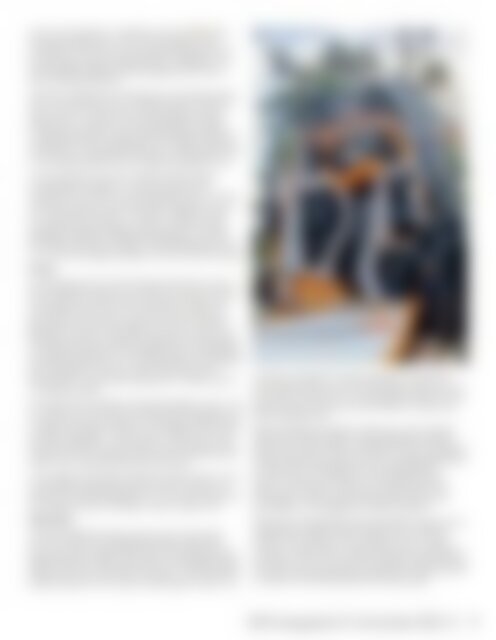NZPhotographer Issue 61, November 2022
As of December 2022, NZPhotographer magazine is only available when you purchase an annual or monthly subscription via the NZP website. Find out more: www.nzphotographer.nz
As of December 2022, NZPhotographer magazine is only available when you purchase an annual or monthly subscription via the NZP website. Find out more: www.nzphotographer.nz
Create successful ePaper yourself
Turn your PDF publications into a flip-book with our unique Google optimized e-Paper software.
many circumstances. I regularly use my D500 body<br />
for biology fieldwork, as it’s a much lighter, more<br />
compact, and I have enough spare batteries to last<br />
me through at least a week without charging. If I’m<br />
shooting high-stakes bird photography (for work or<br />
fun!), it’ll be with the Z9.<br />
I love the versatility of shooting with a full-frame body<br />
that can easily swap to a cropped sensor mode for<br />
extra ‘reach’. The autofocus technology with eye<br />
detection is amazing. I’m also exploring the ability<br />
to take high-quality videos while looking through the<br />
viewfinder, which is impossible with a DSLR. Moving to<br />
an electronic viewfinder has been an adjustment, but<br />
I can swap between the two pretty seamlessly now.<br />
I must stress that you don’t need the latest gear<br />
to take great images. It’s nice to have but not<br />
necessary. For most of my photographic life, I’ve shot<br />
with second-hand, hand-me-down equipment, and<br />
it’s never held me back. I’ve been waiting a while<br />
for mirrorless technology to catch up with the solid<br />
reliability of DSLRs for wildlife photography, and the<br />
Z9 is finally that step change. It’ll be interesting to see<br />
how the technology develops over the next few years.<br />
Lenses<br />
I’m still using all my F-mount lenses with the Z9 via an<br />
FTZ II adapter, although I’ve had the chance to shoot<br />
with some of the new Z lenses and have been very<br />
impressed! They’ll be on my wish list for a while. My<br />
go-to lens for the past six years has been the Nikon<br />
80-400mm f/4.5-5.6. Versatility is key to my work, from<br />
intimate portraits to wider environmental ‘birdscapes’.<br />
My other favourite lens is the 300mm f/4, for absolutely<br />
unrivalled sharpness. If I’m packing light for a research<br />
trip, the 300mm is the lens I reach for every time.<br />
Sometimes if I need a bit more reach, I’ll pair it with a<br />
1.4x teleconverter.<br />
For wide and occasional astrophotography work, I use<br />
a 12-24mm f/4. This DX lens is limited in that regard, but<br />
it’s light and sharp enough for my needs. When I have<br />
to really travel light, I have an old 18-200mm f/3.5-6.3.<br />
This lens is getting on a bit and isn’t very sharp at the<br />
long end, but it’s a great all-rounder for tramping with<br />
when I don’t feel like taking the whole lot!<br />
I very rarely use a tripod, except for night work. I have<br />
a small SIRIU T-025X travel tripod which works for my<br />
forays into astrophotography. I’m not sure it’ll be up to<br />
the weight of the Z9, though I haven’t tried it yet!<br />
Other Gear<br />
Carrying telephoto lenses around on a neck strap<br />
isn’t fun. I have a CarrySpeed shoulder sling strap<br />
that distributes weight a bit better for carrying the 80-<br />
400mm around, which clips onto a dovetail lens plate<br />
attached to the small foot of the lens – I find this extra<br />
length makes it much more comfortable to hold. I’ve<br />
actually managed to wear through the metal ball<br />
and socket joint on one of these straps, and I’m on to<br />
my second. Otherwise, I have neoprene OpTech neck<br />
straps that are a bit more comfortable to wear than<br />
plain webbing ones.<br />
Spare batteries and spare cards are a must. Usually,<br />
these are tucked inside a small waterproof drybag,<br />
along with a few smooth microfiber cloths for cleaning<br />
lenses. Things that I always have in my bag (regardless<br />
of whether I’m biologist-ing or photographing!)<br />
include a knife, a multitool, and some good duct<br />
tape. I once forgot to pack my camera strap and<br />
managed to rig up a serviceable sling strap out of<br />
duct tape, so it’s definitely a worthy inclusion!<br />
The top of my bag always has sunscreen, snacks, and<br />
safety gear (PLB, first aid kit, head torch). The front<br />
pocket can swallow a lot of things as well – there’s<br />
usually a water bottle, waterproofs (top and bottom),<br />
a beanie, a rain cover for the camera, and sometimes<br />
my pair of binoculars (Nikon Prostaff P511 8x42) as well<br />
if I need to be identifying distant flying things.<br />
<strong>NZPhotographer</strong><br />
<strong>November</strong> <strong>2022</strong><br />
9

















